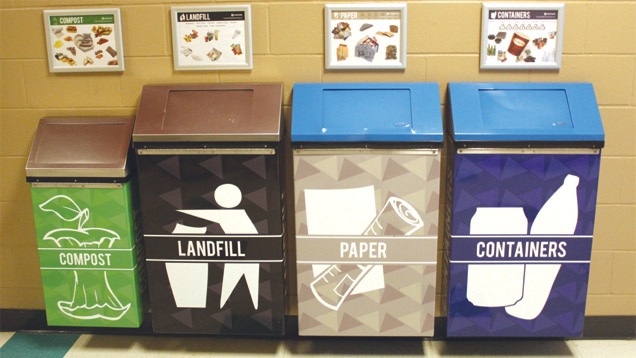Be familiar with waste removal in the city
 CREDIT: JESSICA THOMPSON
CREDIT: JESSICA THOMPSONBins such as these are set up around Fanshawe in order to guarantee students are recycling what needs to be recycled and helping maintain London's environment.
Canada is a country known for their free health care, but apparently, we do not fare as well when it comes to wasting our natural resources that include energy and water. And let’s not forget about our garbage that accumulates throughout city to city and across province to province.
According to the ecoissues website, every day Ontario generates more than 33,000 tonnes of waste. Doing the math, over a course of a year this adds up to more than 12 million tonnes, or 900 kg per person.
Lets recall the garbage strike in Toronto back in 2002 and 2009; that problematic situation left a city stinking and front boulevards littered with too much waste for a city to handle. In addition, this led to the closing of camps and outdoor pools.
Here in London, if you want to know more about how you can assist in a cleaner city, head down to City Hall and pick up a Waste Reduction & Conservation Calendar. Or take a look at the City of London website where you can see where your zone is and when the day and time of garbage pick-up occurs.
Also, keep in mind that Oct. 19 until Oct. 25 is Waste Reduction Week in Ontario. This week’s purpose is to educate, engage and empower Canadians to reduce, reuse and recycle waste.
It was back in the ’80s when the adage “reduce, reduce, recycle” came about not far from London. Fifteen hundred homes were tested in Kitchener, Ontario and followed the blue box recycling system. Although blue boxes are the majority, there are green boxes, green bins, grey boxes and blue bags used within Canada from the west to the east coast.
Food waste is another issue and research from London’s 2015–2016 Waste Reduction and Conservation Calendar, suggests 20 per cent of food waste tossed away is avoidable. Londoners may be spending up to $60 million per year on wasted food that could have been avoided.
In addition, there are many materials that are too dangerous to throw away in the garbage or put down your drain.
According to the City of London website, materials that are corrosive, flammable, ignitable, or reactive such as bleach, nail polish removers, household cleaners and batteries, need to be disposed of properly. In addition, car care products and car products in general as well as lawn care products are extremely dangerous to throw away or to toss in a blue bin.
To find out where household special waste can be discarded, visit the Household Special Waste Depot at 3502 Manning Drive. They are open Tuesday through Friday from 8 a.m. to 4 p.m. and Saturdays from 8 to 3 p.m.
Another topic of waste reduction is yard material collection. While grass clippings, rocks, dirt and soil, large branches, painted and treated wood, kitchen food scraps and animal waste are not accepted there are a few yard scraps that are, such as plant trimmings, brush, leaves and pumpkins.
Lastly, old electronics can be recycled too. You can drop off old iPods, TVs, stereos, computers and many other electronic devices at over 20 locations in the city. Goodwill, Salvation Army and Value Village accept old electronics, as long as they are in good condition, but restrictions do apply.
Hopefully, taking advantage of the resources in London will keep our city the energy efficient Forest City that it is known for.














